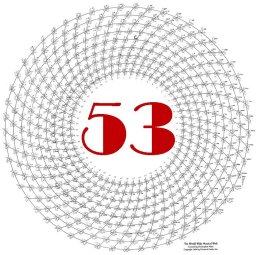Next Page: 11/5 – Seventh Chords
Condissonance
Two “Condissonant” Triads. A triad that has both consonant and dissonant elements is called “condissonant.” These two chords are not in the traditional music theory lexicon, but their harmonic ratios are simple enough to merit mention:
Figure 11-11: Condissonant triads
[C – E1 – B1 ] E1 — B1 and… [C — G — B1 ] B1
. | |
. C C — G
On the piano, the C-to-B interval sounds harshly dissonant. In just intonation or 53-eq, to me the sound of C to B1 is more spicy than it is bitter. The ratio, 15/8, is still simple enough for the ear to grasp; the one fifth + one third pathway is easy to follow; and the tones do merge every 120 vibrations of the C to B1 on the oscilloscope. And all the other intervals – C to E1, C to G and E1 to B1, are pure consonances. There may be other “condissonant” collections of three notes which could not be called triads at all, but which can be of great interest to composers. We will cover these more thoroughly in Chapter 15 when we talk about “tone clusters.” In the 20th century, with the breakdown of triadic harmony and tonal centers, some composers organized their music around other intervals like the perfect fourth (C – F – Bb — Eb) or other harmonically related pitches such as A1b – C – B1.
If you would like to learn more about this chapter, “Condissonance,” as well as how the 53-equal tuning palette can shed new light on traditional tonal music, you can buy the entire book, The Grand Unified Theory of Music, in pdf form for $25 with hundreds of embedded musical examples of scales and chords from all over the world.
A free introduction to what The Grand Unified Theory of Music offers is on this website and includes both text and a few musical examples from each webpage. If you would like to learn more about this chapter and the full contents of this entire e-book, you can buy The Grand Unified Theory of Music for $25, with hundreds of embedded musical examples of scales and chords from all over the world — and ideas for how to set up your computer system —
HERE.
You’ll get a personalized password you can use to see the entire e-book. Inside the full book, you will also get a link to the complete pdf file of this e-book, which you can read on your Kindle or similar device. The links to the hundreds of mp3 sound files – the same ones you can hear on the website — will also be included. This is “Version 1.0” of The Grand Unified Theory of Music. Because it is an e-book, additions, corrections and improvements in the sound may be added at any time. The Grand Unified Theory of Music is Copyright © 2018 by Christopher Mohr. All rights reserved.
One person per password. Sharing this password with others is a violation of copyright. Do not allow others to use your password or link to the pdf file!
